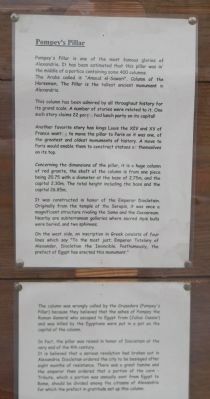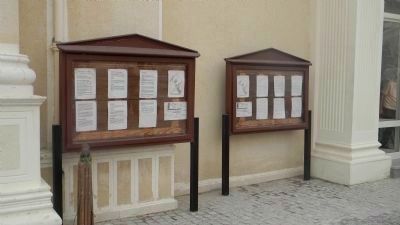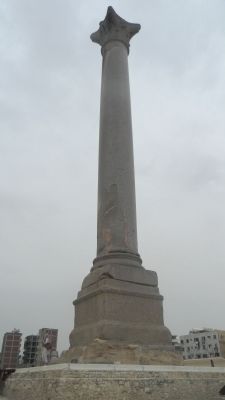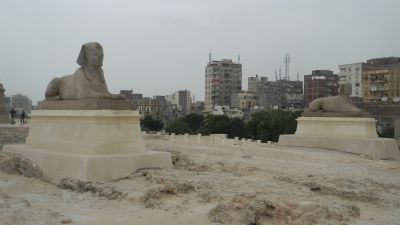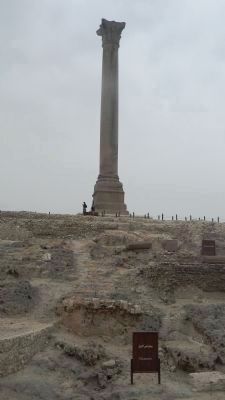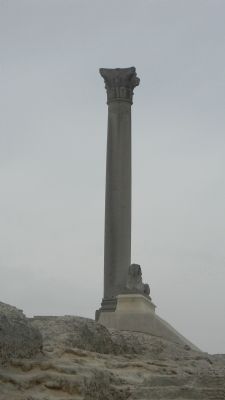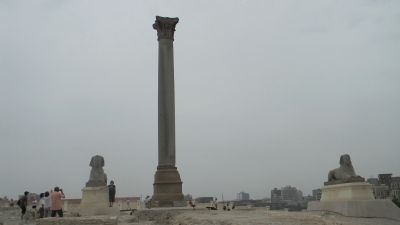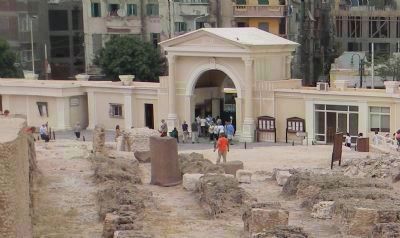Alexandria in Karmouz, Egypt — مصر (Northeast Africa)
Pompey's Pillar
— [Alexandria Serapeum] —
Pompey’s Pillar is one of the most famous glories of Alexandria. It has been estimated that this pillar was in the middle of a portico containing some 400 columns. The Arabs called it “Amoud el-Sawari”, Column of the Horsemen. The Pillar is the tallest ancient monument in Alexandria.
This column has been admired by all throughout history for its grand scale. A number of stories were related to it. One such story claims 22 people had lunch on its capital!
Another favorite story has Kings Louis the XIV and XV of France wanting to move the pillar to Paris as it was one of the greatest and oldest monuments of history. A move to Paris would enable them to construct statues of themselves on its top.
Concerning the dimensions of the pillar, it is a huge column of red granite, the shaft of the column is from one piece being 20.75m with a diameter at the base of 2.75m, and the capital 2.30m. The total height including the base and the capital 26.85m.
It was constructed in honor of the Emperor Diocletain [sic], Originally from the temple of Serapis, it was once a magnificent structure rivaling the Soma and the Caesareum. Nearby are subterranean galleries where sacred Apis bulls are buried, and two sphinxes.
On the west side, an inscription in Greek consists of four lines which say “To the most just; Emperor Tutelary of Alexandria, Diocletian the Invincible. Posthumously, the prefect of Egypt has erected this monument.”
This column was wrongly called by the Crusaders “Pompey’s Pillar” because they believed that the ashes of Pompey (the Roman General who escaped to Egypt from Julius Caesar and was killed by the Egyptians) were put in a pot on the capital of the column.
In fact, the pillar was raised in honor of Diocletain[sic] at the very end of the 4th century.
It is believed that a serious revolution had broken out in Alexandria. Diocletain[sic] ordered the city to be besieged after eight months of resistance. There was a great famine, and the emperor then ordered that a portion of the corn tribute [… annually sent from Egypt to Rome] should be divided among the citizens of Alexandria - for which the prefect in gratitude set up this column.
Erected by Supreme Council for Antiquities.
Topics. This historical marker is listed in these topic lists: Churches & Religion • Landmarks.
Location. 31° 10.95′ N, 29° 53.787′ E. Marker is in Alexandria, in Karmouz. Marker is on Karmooz [Pompey's Pillar] just south of Abi Wakas Lane. Marker is on the site of the Classical Alexandria Sarapeum.
Touch for map. Marker is in this post office area: Alexandria 21514, Egypt. Touch for directions.
More about this marker. Marker is on the site of the Alexandria Sarapeum: a ruined temple once dedicated to the Greek-Egyptian deity, Sarapis.
Also see . . .
1. The Sarapeion, including Pompay's Pillar in Alexandria, Egypt. (Submitted on September 30, 2012, by Richard E. Miller of Oxon Hill, Maryland.)
2. Serapeum. A serapeum is a temple or other religious institution dedicated to the syncretic Hellenistic-Egyptian god Serapis, ... (Submitted on September 30, 2012, by Richard E. Miller of Oxon Hill, Maryland.)
Additional keywords. Column of Diocletian; Alexandria Serapeum (Sarapeion); "Alexandria Acropolis"
Credits. This page was last revised on February 11, 2022. It was originally submitted on September 30, 2012, by Richard E. Miller of Oxon Hill, Maryland. This page has been viewed 3,877 times since then and 46 times this year. Photos: 1, 2, 3, 4, 5, 6, 7, 8. submitted on September 30, 2012, by Richard E. Miller of Oxon Hill, Maryland. • Bill Pfingsten was the editor who published this page.
